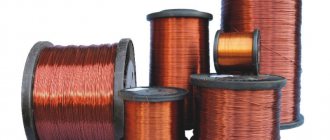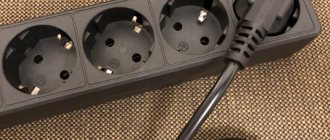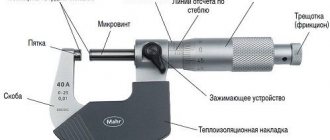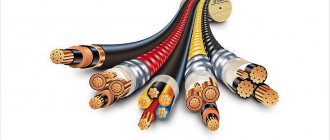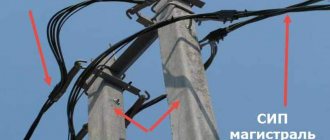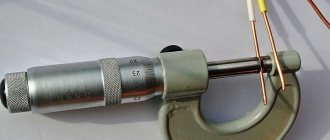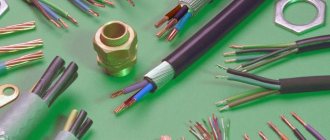Why do you need a grounding wire, how it works
Connecting a ground wire to a bus
The main purpose of grounding is to prevent electric shock to a person or animal. A serviceable electrical device has a complete body with reliably insulated parts that are energized. If a household appliance breaks down, live parts may touch the housing and this will lead to the fact that it will also be energized. By touching such a device, a person will inevitably receive an electric shock.
In this case, the operation of a circuit breaker is impractical, since the current flowing through the human body will not be enough to turn off the power supply. But this force, unfortunately, is enough to deprive a person of health or even life.
To eliminate the possibility of such events, you need to ground all electrical devices through conductors. Grounding household appliances at home is only possible if the house is equipped with a ground loop. Unfortunately, houses in older buildings are not equipped with such innovations. This is due to the fact that decades ago people had practically no household appliances in their homes, therefore, the load on the network was minimal.
Now another conductor is added to the two-phase wiring - a grounding wire. As a result, the wiring is already three-phase - two wires are zero and phase, and the third is protective grounding. Thus, when connecting the plug of a household appliance to a socket, the metal body of the device is automatically connected to the protective ground.
Briefly about the terms
To make the article understandable even for those who are far from electrical engineering, we have provided an explanation of the terms that will be used in it.
The ground electrode is the basis of the grounding system. Usually it consists of metal pins driven into the ground at an equal distance from each other, forming a figure like a triangle.
A grounding bus or GZSh is a metal strip laid along the perimeter of the room or near the protected devices, which connects all the grounding conductors of electrical devices to the ground electrode.
The grounding wire or conductor is the conductor that provides the connection of the ground electrode to the main switch.
Metal bonding is a concept that characterizes the contact between metal parts of electrical equipment housings, including the doors of electrical panels or cabinets with their housings.
Criteria for selecting a grounding cable
Grounding Schemes
Before choosing a grounding conductor, you need to understand several important points.
Owners of private houses and country buildings built in 1998 and earlier are forced to carry out grounding themselves. Modern buildings are equipped with a ready-made system even during the construction process.
To choose the right grounding wire and its cross-section, you need to find out what system is installed in the house. According to the Electrical Installation Rules, 4 types can be used:
- TN-S - in the AC system, additional grounding is carried out using a neutral and a separate wire.
- TN-C is characterized by combining the zero and ground wires, the neutral is output separately. The most common method of protection, which was used in Europe several decades ago.
- TT – equipping electrical equipment with direct protective grounding.
- IT – work directly with the housings of household appliances through complete insulation of all conductive cables and the housing itself.
The grounding diagram used should always be marked. In Russia you can find two of them:
- PE – grounding;
- PEN – neutral and ground are combined in one cable.
The next important selection criterion is the type of grounding used. Depending on their purpose, they are divided into two types - portable and stationary. In domestic conditions, a stationary type is sufficient, which allows the operation of both single-core and three-core cables.
Many people who are poorly informed in these surveys have difficulty figuring out what color the ground wire is. According to the requirements of the PUE, the wire must be made in yellow-green insulation color.
After determining the type of cable and material of the system, you can proceed to the next main step - selecting a suitable cross-section.
Requirements
Requirements for the grounding wire are made in accordance with the local conditions in which electrical installations are operated. They may also differ in accordance with the assigned tasks or operating mode. All requirements can be divided according to the following parameters of grounding wires:
- Single-core or stranded - used depending on the specific equipment. Thus, stranded wires should be installed in areas where a certain level of flexibility is required and the ground must be easy to move (cell doors, test equipment, etc.). Single-core wires provide rigid fixation and are attached to the housings of stationary equipment.
- Presence or absence of insulation - an insulating layer is required when laying openly or along equipment casings.
- Separately laid or located as part of a solid cable - with a combined design in single-phase systems it should be carried out with a three-core cable, and in three-phase systems with a five-core cable. If the system is already installed, it must be carried out with a separate grounding conductor.
- The material of the conductive element (copper, aluminum, steel) determines the resistivity of the conductor itself and its chemical resistance to various environmental influences. Copper conductors are the most resistant to corrosion and have the lowest resistivity, followed by aluminum and steel.
The most important requirement for the grounding loop and the conductor connected to it is the total ohmic resistance. Which is determined by the cross-section of the ground wire, and the transition resistance between the circuit blades and the ground, and the places of bolted (terminal) or welded connections in the common circuit. The total value of the circuit resistance is determined by clauses 1.7.101 - 1.7.103 of the PUE, depending on the linear or phase voltage of the electrical installation and its type, these parameters are given in the table below:
Table: grounding resistance value
| Type of grounded electrical installation | Line voltage value Ul, V | Phase voltage value Uph, V | Grounding resistance R, Ohm no more |
| Connection points for neutrals of generators, transformers and other current sources | 660 | 380 | 2 |
| 380 | 220 | 4 | |
| 220 | 127 | 8 | |
| Connection points located near the connection points of neutrals of generators, transformers and other current sources | 660 | 380 | 15 |
| 380 | 220 | 30 | |
| 220 | 127 | 60 | |
| Places for repeated grounding of overhead lines and supply lines | 660 | 380 | 15 |
| 380 | 220 | 30 | |
| 220 | 127 | 60 |
In addition to copper wires in accordance with clause 1.7.121 of the PUE, for grounding it is allowed to use a metal armored shell used to protect against mechanical damage when laying cables, ducts and trays, if their placement excludes the possibility of their damage, rails and beams in the construction of buildings and structures .
But, according to the requirements of clause 1.7.123 of the PUE, it is prohibited to use metal parts of gas pipelines or water supply pipes, loaded reinforcement of reinforced concrete structures as grounding conductors.
How to choose the right cross-section of the grounding conductor
An example of a cable with a smaller cross-section of PEN cores.
To connect the protection system, not only natural grounding conductors can be used, but also artificial ones. The selection rules in each case differ from each other and have their own technical features.
Networks with a power of more than 1 kW are equipped with artificial ones; in other cases, the operation of natural ones is permissible.
The artificial segment is made of galvanized alloys, steel and copper. The cross-section is selected in accordance with the Electrical Equipment Installation Rules in special tables.
| Material | Section profile | Diameter(mm)/Cross-sectional area(mm.sq) |
| Copper |
|
|
| Cink Steel |
|
|
| Black steel |
|
|
One simple but important rule is that the conductor must have a cross-section that is equal to the cross-section of the phase wire, provided that the conductor is at least 16 mm2. In other cases, the cross section is calculated using the table given in the PUE.
| Section of phase conductors, mm.sq. | Smallest cross-section of protected conductors, mm.sq. |
| S>35 | S/2 |
| 35>S>16 | 16 |
| S<16 | S |
In an ordinary apartment, which is equipped with all the necessary equipment, it is enough to install a protection system with a single-core wire with yellow-green insulation.
Wire marking
Grounding wires have another characteristic feature - markings.
Ground color
Grounding, according to the rules of the PUE, must be painted yellow-green. However, it is rare to see light green or all yellow wires. The cable can also be equipped with a blue braid at the fixation points, which indicates grounding along with zero.
In the distribution panel it is connected to the busbar, housing and panel door made of metal. In the box, the connection tends to the ground wires. The grounding conductor must not be connected to the residual current device.
Symbols on electrical diagrams: for direct current, standard grounding, to the electrical equipment housing, clean and protective.
Neutral color
An example of the appearance of a neutral wire.
The neutral conductor is strictly blue in color. In the distribution panel it must be connected to the neutral bus, which is designated by the letter N. All remaining blue conductors are connected to it. Through an electric meter or directly without installing a machine, the bus is connected to the input. In the distribution box, all wires, with the exception of blue, should not be used for switching. Neutral conductors in sockets are connected to the contact designated N - located on its back side.
Phase color
Compared to ground and neutral, phase has a wider range of colors. Any colors except blue, yellow and green can be used to designate a wire. The most common are black, red and brown.
In the distribution box, the phase that leaves the consumer is connected to the contact of the automatic switch located at the very bottom, or the residual current equipment. The switches carry out phase switching.
Independent wire designation
From time to time there are conductors with unusual colors. Such solutions do not comply with the standards set out in the PUE. To make the task easier, it is recommended to label the wires yourself with the necessary colors. Colored electrical tape and heat-shrinkable tubing are used for this.
Another task of the master is to write down the meanings of the colors separately on a piece of paper.
Connection
Before connecting, it is necessary to mark the main terminals of five or three-wire wires. If you are just doing installation work, you will be able to independently determine which wire to connect where, otherwise you will have to understand the existing wiring. In practice, to determine the location of all types of wires in the connection diagram, use their color designation:
- Phase conductors - have a wide variety of spectrum (brown, red, gray, purple, etc.);
- Grounding conductors are made in yellow-green color, some manufacturers use only bright green color;
- Neutral conductor – blue or cyan.
However, note that not all installers follow the standard marking procedure or the wire itself may not correspond to the power supply diagram, so before using a ground or phase wire, it is worth ringing them first.
The connection itself is made in such a way as to ensure the most reliable contact with zero or close to it transition resistance. Therefore, the most acceptable is soldering, crimping or tightening under a nut or tip.
It is strictly forbidden to make an electrical connection to the grounding wire by twisting or other non-standard methods. If a copper and aluminum conductor are connected, a brass gasket must be installed between them or they are crimped into a sleeve. Next, the grounding wire is connected from the circuit to the equipment body, metal elements to equalize the potential, or to the corresponding socket contact.
Main brands of grounding cable
Options for color marking of the ground wire
When choosing a cable brand, you need to study its type: mobile or stationary use. Stationary is designed to protect equipment, distribution panels and structures. The best option is multi-core stranded cables (VVG, PVG) and single-wire modifications (NYM). If the ground cable is colorless, the ground is directed towards the core.
- NYM cable – the sheath is painted in accordance with all rules and regulations, and the inside is equipped with copper conductors. It also has an intermediate additional sheath, which increases the service life of the cable even with prolonged use. Does not cause any difficulties during installation.
- VVg - equipped with conductors made of copper of the first and second class of twist. It has an unusual color that is worth paying attention to. Earth is yellow-green, and zero is blue. The outer sheath and insulation are made of polyvinyl chloride, thanks to which the cable will not burn even in the event of a fire.
- PV-6 – copper wire, the sheath is made of transparent PVC. It is possible to contemplate the work of a conductor. Operating temperature range -40 – +50 degrees Celsius, very flexible material.
- ESUY has one standard application - system short circuit protection. Capable of withstanding enormous loads, they are often used in junction boxes and on railways.
- PV-3 can be produced in 11 colors and consists of a large number of copper threads, which are placed in a polyvinyl chloride shell. The peculiarity of the outer shell is fragility if improperly stored or used.
The issue of choosing a grounding cable is extremely important, since an incorrectly selected core will be unable to perform all the technical tasks assigned to it. If you have difficulties making your own choice, it is better to consult a specialist.

